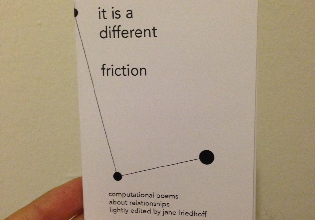Miscellaneous Projects of 2015
In an attempt to remind myself, in my pneumonia-induced exhaustion, that I have actually done a decent amount of side projects this year, I thought I’d round up some of the smaller works that didn’t make it onto my portfolio.
Baleet, a tool to help manage your Twitter archive.
@ra ramsey i need you to know that i coded a tool for myself & it p much WORKS & DOES WHAT I WANT & IS THIS WHAT IT FEELS LIKE TO BE YOU
— jane frie(n)dhoff (@JFriedhoff) November 26, 2015I’ve already written about Baleet on this blog, so I won’t go into that much detail. But I was pretty psyched about it.
@_tiny_tarot, a Twitter bot that tweets one Tarot card per day.
today's card is The World. let's think about how we can find harmony. pic.twitter.com/qw6BvOxzEj
— tiny tarot (@_tiny_tarot) December 9, 2015Although I’ve been programming for ages, it’s only been within the last few years that I actually started drilling down into web programming specifically. A lot of this year was learning proper frontend, learning any backend at all, and–with this project–learning how to deploy stuff.
Of course I didn’t start from the tech angle. Instead, I started–as with most tools that I end up making–by disappointing myself, namely disappointing myself with my inability to remember to draw a daily Tarot card. I don’t know how I can go to the gym every day and do elaborate skincare routines every day and forget to draw a single damn card from a single damn deck. Regardless, I realized that I could pretty easily write a bot to do it for me (a bot familiar, if you will, har har). It seemed like a neat way to play with what it means for me to do something, plus it was just something I really wanted.
@_tiny_tarot is a small NodeJS app with a big ol’ JSON file of cards, meanings, and images. I’ve done that sort of stuff before; the big deal to me was finally deploying something myself. Heroku made the process pretty straightforward, and once I got the guts to put my credit card info in (still haven’t been charged at least), I hooked it up to scheduler too.
when was the last, an installation piece.
This summer I got the opportunity to attend the School For Poetic Computation summer session, which was all about code poetry. It was a really interesting shakeup from what I usually do, both in my day job and as my personal practice. For one of my final projects, I made a super-simple installation piece called “when was the last”. All it does is cycle through a list of emotional states, choose two, and then display a prompt that says “when was the last time you felt [x] and [y]?”
I wouldn’t be surprised if a lot of folks went all modern art critique on it, like, “Oh c’mon, I could do that.” But I like the piece, and I like how simple it is. It prompts my brain into trying to think of a story for each pairing, and I was surprised at what came up.
it is a different friction, a short chapbook of generated poems about relationships.

This was my second final project for SFPC. The poems were generated with the command line, using various zodiac compatibility reports for me and my partner as source texts. The resulting text was shuffled, rearranged, and lightly edited. The constellations on the five covers were generated in Processing.
I wrote a little poetry in college (it was just as good as you’d expect it to be), and while it isn’t my area of expertise, after taking Allison Parrish’s class I had to give it a try. It was also a neat experiment in producing something tangible fast and for the public–I printed up and folded about 200 mini-zines for free, with all of them being taken by the end of the night. You can download the chapbook for pay-what-you-want here.
untitled ambient installation piece, which cycles through unicode characters.
This is even simpler than the first one. All this does is quickly loop through all the Unicode characters. It’s not even my idea: Nick Montfort showed a version in his SFPC session that I thought was awesome.
But it’s not so much any technological innovation that makes me include it here. What makes me pleased about it is that, after like 7 years, I’ve finally started to make ambient stuff for parties again. This was a huge component of my youth from, like, college through grad school, and I’ve missed it. This was an easy way to get back on that horse.
Slam City Oracles arcade cabinet.
Technically SCO is on my portfolio, but the arcade cabinet isn’t, and that sure counts as work. The excellent Mark Kleback asked if I wanted to be part of the Death By Audio Arcade Collective, and I of course agreed. Seeing a game I made in an arcade cabinet was just irresistible to me. He guided me through the whole process and let me use his workshop, and not too long later, we had a proper home for SCO. This Vine shows the cabinet in a slightly unfinished state, but it highlights my favorite things about it: the console illustrations and, of course, the enormous buttons.
Liked this post? Want to buy me a coffee? Throw me a tip here, if you like.